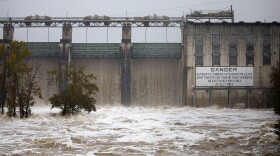Austin Water delivered an “after action” report to City Council today on the weeklong boil-water order enacted during severe flooding in October. During its presentation, the utility shed more light on what happened to bring about the emergency and what the city might do to avoid future water-boil mandates.
When it issued the order Oct. 22, Austin Water said the murkiness of floodwater had overwhelmed treatment capacity and could endanger water quality. But the more immediate risk appears to have been to water quantity in Austin’s rapidly diminishing reserve of treated water.
Austin Water Director Greg Meszaros said the amount of water flowing into Lake Travis was the most since the Mansfield Dam was built nearly 80 years ago. The city’s water-treatment systems could not keep up, resulting in falling reservoir levels.
On Oct. 21, the city put out an urgent call to conserve water, but Austin Mayor Steve Adler said Tuesday there was not enough response. He said it was the later water-boil order that convinced the community of the need to replenish that supply.
“As soon as people looked at having to boil water ... people understood the severity of the moment,” he said. “And then there was the dramatic reduction in water usage.”
That’s not to say water quality did not eventually become a problem. Four days after the boil order went into effect, Austin's drinking water briefly exceeded regulatory levels for “turbidity” or murkiness.
The water-boil order was lifted Oct. 28.
To prevent the need to issue a future water-boil order, Meszaros told council members the utility is working with outside consultants, looking into different chemical processes for treating overly murky water.
"I'm not saying that we're Flint or we're going to be Flint, but you have to be very thoughtful about process changes so you don't destabilize your distribution system."
But, he said, the utility needs to be cautious as it looks at overhauling its treatment processes, evoking the water contamination crisis in Flint, Mich., as a cautionary tale.
“They changed very radically [their treatment process for] water quality and water sources, and we all know what happened at Flint,” he said. “I’m not saying that we’re Flint or we’re going to be Flint, but you have to be very thoughtful about process changes so you don’t destabilize your distribution system.”
The utility also said adding extra treated water storage capacity could help, as it would buy the city more time to treat floodwater in the event of a similar storm.
Since the order was lifted, Meszaros said, the level of murkiness in water flowing out of Lake Travis is still not what it was before the October flooding. The extra silt likely had a negative effect on the zebra mussels that gather on the intake pipes in Lake Travis.
He added, however, that the challenges of flooding and poor water quality are expected to increase as climate change brings more extreme weather to Texas.
KUT's Trey Shaar contributed to this report.








